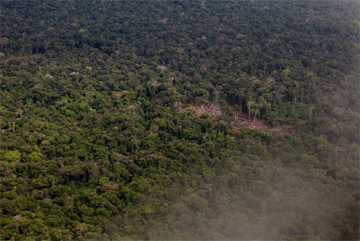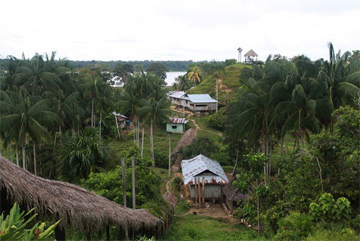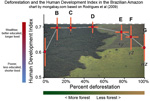Urbanization may be having unexpected impacts in the Amazon rainforest by leaving forest areas vulnerable to exploitation by outsiders, report researchers writing in Conservation Letters.
Conducting field surveys during the course of 10,000-kilometers of travel along remote Amazon rivers, Luke Parry of Lancaster University found that a sharp decrease in rural habitation has not been accompanied by a decline in harvesting of wildlife and forest resources, indicating that urban populations exact a heavy toll on distant forests through hunting, fishing, logging, and harvesting of non-timber forest products.
“You might think that as people leave the forest there would be a conservation gain – that the abandoned land and rivers would be left to nature. However, we found that wasn’t the case. Although plants and animals were no longer being farmed and harvested by subsistence resource users, other more commercial activities moved in,” said Parry in a statement.
 One of the Amazon river dwellers interviewed by Parry. Photo by Parry. |
“We found evidence that commercial activity continued on the rivers many hundreds of miles beyond the last rural household. Much of the harvesting we observed was to supply the demand for wild foods such as turtles, fish and forest animals to service growing demand from the Amazon’s burgeoning urban population.”
Parry said that abandoned land was more likely to be colonized by speculators, who cut down forest for cattle pasture, hoping to capitalize on appreciating land values. Under Brazilian law, forest-clearing is one of the easiest ways to gain property rights on unclaimed land.
“When people leave the villages they leave behind a vacuum,” he said. “When the land isn’t occupied the forest is exposed to the threat of large scale deforestation and unregulated land speculation in abandoned headwaters which is a real possibility in some areas due to expansion of the road network.”
Brazil’s road network in the Amazon is fast-expanding under the country’s infrastructure development plan. Highways like the recently paved BR-319 have greatly improved the viability of ranching and large-scale agricultural production in the region, driving up land prices and fueling speculation, usually by non-residents who follow the resource frontier.
 Small-scale forest clearing in the Amazon rainforest.  Small community along the Amazon river. |
“Whereas Amazonian communities often exhibit coping strategies in the management of commons resources, nonresident actors often lack the property rights necessary to exploit a resource sustainably,” write Parry and colleagues, including Carlos A. Peres, Brett Day, and Silvana Amaral. “The lack of institutional presence and unclear property rights in remote abandoned headwaters of Amazonas may allow the perpetuation of an incomplete forest-transition, where the ‘mining,’ rather than management of forest resources continues unabated.”
The authors say the findings cast doubt on the argument advanced by some researchers that rural abandonment would be a boon to conservation by reducing deforestation and allowing forest recovery. Instead, Parry and colleagues argue for providing incentives to stabilize rural populations and promote sustainable use. Payments-for-ecosystem services — like the scheme currently offered by the Amazonas state government — could serve as a means to support such communities.
“For those areas not yet abandoned we encourage efforts to sustain low-density rural populations through the federal or state demarcation of inhabited sustainable use reserves,” the authors write.
“When given land tenure, rural people can assist conservation by maintaining forest cover to ensure environmental services such as carbon retention and water cycling, and prevent illegal landgrabbing and violence. Rural people can be key agents in sustaining biodiversity through agro-ecological practices that maximize the matrix value of anthropogenic landscapes.”
CITATION:
Luke Parry, Carlos A. Peres, Brett Day, & Silvana Amaral. Rural-urban migration brings conservation threats and opportunities to Amazonian watersheds. Conservation Letters xx (2010) 1–9
RELATED
Commodity trade and urbanization, rather than rural poverty, drive deforestation

(02/07/2010) Deforestation is increasingly correlated to urban population growth and trade rather than rural poverty, suggesting that measures proposed to reduce deforestation will be ineffective if they fail to address demand for commodities produced on forest lands, argues a new paper published in Nature GeoScience.
Amazon deforestation doesn’t make communities richer, better educated, or healthier

(06/11/2009) Deforestation generates short-term benefits but fails to increase affluence and quality of life in the long-run, reports a new study based an analysis of forest clearing in 286 municipalities across the Brazilian Amazon. The research, published in Friday’s issue of the journal Science, casts doubt on the argument that deforestation is a critical step towards development and suggests that mechanisms to compensate communities for keeping forests standing may be a better approach to improving human welfare, while simultaneously sustaining biodiversity and ecosystem services, in rainforest areas.
Just how bad is the biodiversity extinction crisis?

(02/06/2007) In recent years, scientists have warned of a looming biodiversity extinction crisis, one that will rival or exceed the five historic mass extinctions that occurred millions of years ago. Unlike these past extinctions, which were variously the result of catastrophic climate change, extraterrestrial collisions, atmospheric poisoning, and hyperactive volcanism, the current extinction event is one of our own making, fueled mainly by habitat destruction and, to a lesser extent, over-exploitation of certain species. While few scientists doubt species extinction is occurring, the degree to which it will occur in the future has long been subject of debate in conservation literature. Looking solely at species loss resulting from tropical deforestation, some researchers have forecast extinction rates as high as 75 percent. Now a new paper, published in Biotropica, argues that the most dire of these projections may be overstated. Using models that show lower rates of forest loss based on slowing population growth and other factors, Joseph Wright from the Smithsonian Tropical Research Institute in Panama and Helene Muller-Landau from the University of Minnesota say that species loss may be more moderate than the commonly cited figures. While some scientists have criticized their work as “overly optimistic,” prominent biologists say that their research has ignited an important discussion and raises fundamental questions about future conservation priorities and research efforts. This could ultimately result in more effective strategies for conserving biological diversity, they say.